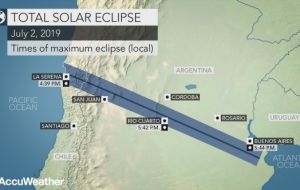MercoPress. South Atlantic News Agency
Solar eclipse Tuesday afternoon stretching from La Serena, Chile to Buenos Aires
 Although the shadow of the moon will traverse the southern Pacific Ocean, the most anticipated part of the eclipse will be when it reaches South America.
Although the shadow of the moon will traverse the southern Pacific Ocean, the most anticipated part of the eclipse will be when it reaches South America.  The first place on the continent to see the total solar eclipse will be La Serena, Chile, and the last place will be just south of Buenos Aires, Argentina
The first place on the continent to see the total solar eclipse will be La Serena, Chile, and the last place will be just south of Buenos Aires, Argentina Day will turn into night on Tuesday afternoon as the sun, moon and Earth align perfectly during the first total solar eclipse since 2017. The eclipse will only be visible across the southern Pacific Ocean and South America, but can be seen anywhere from around the world online through NASA TV.
The eclipse programming will commence at 3 p.m. EDT. No matter where you are in the world, watch a live stream of the total solar eclipse right here on AccuWeather.com.
Although the shadow of the moon will traverse the southern Pacific Ocean, the most anticipated part of the eclipse will be when it reaches South America.
The first place on the continent to see the total solar eclipse will be La Serena, Chile, and the last place will be just south of Buenos Aires, Argentina. Starting local time will be 16:39 until 17:44.
Totality will last for a little over two minutes for people in this narrow area on Tuesday afternoon, while the balance of the continent experiences a partial solar eclipse.
For people experiencing their first eclipse, a lot will happen in the two to two-and-a-half minutes during totality.
The temperature will drop. Bright stars and planets will appear in the darkened sky. Crickets will start chirping. Street lights may turn on. Animals may act differently. Looking down at the horizon will look like there is a sunrise or sunset in every direction. Then before you know it, the first beams of light will shine down and the moon will gradually uncover the face of the sun.
Even those who are only going to experience a partial solar eclipse should pay attention to their surroundings. This includes everyone across Chile, Argentina, Uruguay, Paraguay, Bolivia, Peru, Ecuador and parts of Brazil and Colombia.
“Remember that eclipses are not only about totality and eclipse photography. Enjoy the interesting natural phenomena that occur as the moon progressively obscures the sun,” Dr. Gordon Telepun told AccuWeather. Telepun is an expert eclipse photographer and eclipse educator who has traveled around the globe to witness eclipses.
“Deeper into the crescent phases, be aware of the way shadows are cast to the ground,” Telepun explained. “Shadows that are in-line with the angle of the crescent sun should cast a shadow with a sharp edge.”
It is imperative that anyone looking at the sun during the partial phases use a solar filter to protect their eyes. Looking at the sun without the proper filters can cause permanent eye damage.
“Even if there’s an edge of the sun that’s still visible, you’re still at risk,” said Dr. Howard Purcell, senior vice president of customer development at Essilor of America.
The American Academy of Ophthalmology and the American Astronomical Society recommends wearing eclipse glasses that are ISO 12312-2 certified.
The only time when it is safe to remove your eclipse glasses is during the brief minutes of the total eclipse when the entire face of the sun is being blocked by the moon.
South America will also be home to the next total solar eclipse, set for Dec. 14, 2019.




Top Comments
Disclaimer & comment rulesCommenting for this story is now closed.
If you have a Facebook account, become a fan and comment on our Facebook Page!